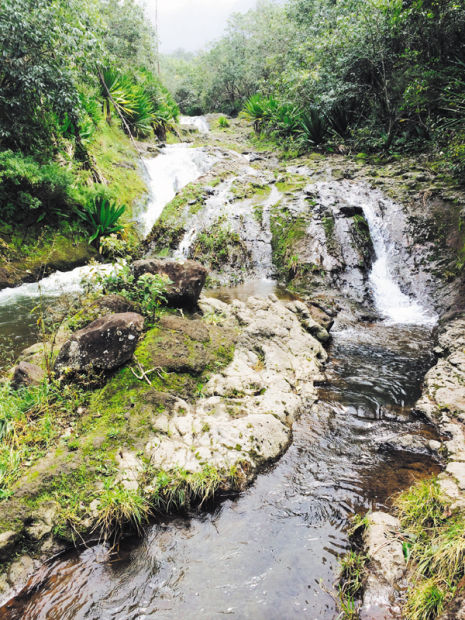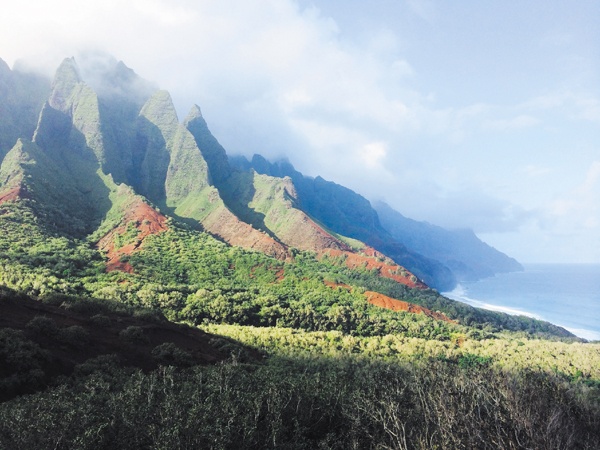Conquering Kalalau
“Take some time. Free your mind.”
These words can be found written in black permanent marker outside one of the campsite restrooms at the famed Kalalau Beach.
Aside from being a slightly comical location for such advice, the words do a fantastic job pinpointing why many people make the 22-mile round-trip trek out to Kalalau.
For me, the purpose of the trip last week was two-fold — pleasure certainly, but also to see firsthand whether the reported problems involving garbage and illegal campers carried weight.
Ironically, according to some fellow hikers, the state Department of Land and Natural Resources had been at the beach only hours before I arrived and hauled away multiple pallets of trash bags.
Some might call it luck, but I found the bathrooms clean, the toilet paper fully stocked and the beach area relatively free of left-behind rubbish (although day hikes off the beaten path did turn up some unexpected piles).
Yes, people live in the area — not much of a surprise there. And while they certainly account for a portion of the trash, many seem to be doing their part to make sure it gets picked up.
In the few days I was back there, I saw several people walking through the campsite and along the beach collecting trash that wasn’t theirs.
As for the experience — my first time hiking the entire trail, in and out — I would describe it as spectacular, lively and freeing.
Kauai’s Na Pali Coast State Park, home of the Kalalau, is a place full of energy and history. Being there feels like an escape from reality. Invasive species and some garbage aside, Kalalau could easily serve as a Garden of Eden movie set.
That’s the draw, the reason upward of 20,000 permitted campers — and a large number of unpermitted ones — find themselves there each year. But in the winter, when the trail turns muddy and large waves keep people from accessing the remote beach by kayak, you really have to work for the experience.
Hike in. Get dirty. Stay awhile. Hike out. And feel good about doing it the way it’s meant to be done — on foot.
Some, like first-timer Craig Winetrout of Eugene, Ore., have a hard time putting the experience into words.
“I just think it’s a whole other world back in here,” he said, sitting on the beach just before sunset with the massive Na Pali cliffs towering overhead. “I could never describe it.”
Winetrout, who spent five nights in Kalalau with his girlfriend Sara McRae, said he got a bit of a kick out of watching the boats and noisy helicopters full of tourists cruise by for a quick, $100-plus glance and a photo.
“You can’t see it from a boat,” he said. “You got to get back in here, you know what I mean? You just got to get right up in close with it.”
And that’s exactly how the adventurous couple chose to spend the first half of their two-week trip to Kauai — tackling a trail that has been included among the World’s Best Hikes, America’s Most Dangerous Hikes and Scariest Cliff Walks.
“After this we’re staying in Princeville for like a week,” Winetrout said. “We wanted to go rough it first, (then) lick our wounds.”
As proof for their fair-skinned friends back in Oregon, the couple took home two nasty sunburns, shaped like backpack straps.
Getting there
Originally, my girlfriend Amy and I planned to hike on Feb. 13. The idea was to be there for both Valentine’s Day and the full moon that accompanied it this year.
“Forget flowers and some expensive dinner, let’s do something awesome outdoors,” was the agreement.
Unfortunately, Mother Nature had a different plan.
We got as far as Hanalei that morning before accepting the reality that we would be crazy to try and hike in such torrential rain. To make our decision easy, the DLNR closed the trail later that morning in light of flash flood warnings.
We were forced to reschedule.
A week later, we awoke to blue skies and were on the trail by 8 a.m. The first six miles felt like a breeze. No pain. All smiles. After lunch at Hanakoa, we mentally prepared for the infamous “Crawler’s Ledge” at mile marker 7.
Personally, I didn’t find the cliff too scary, but watching Amy, who was clearly a bit nervous, made me somewhat uneasy.
Winetrout and McRae had a similar experience. He said he went through the spot not knowing it was indeed Crawler’s Ledge. She, on the other hand, was on the verge of serious anxiety.
“I was sweating really hard,” McRae said. “And I probably made the mistake of looking down too many times.”
Around mile marker 8 is when the backpacks begin to get heavy, the legs turn to jelly and the muscles begin to ache. Others we talked to over the weekend agreed.
“Around mile 8 we really hit a wall,” San Jose resident John Yriberri, who hiked the trail with his best friend Chris Reed of Reno, Nev., later told me. “My legs are tired. I’m out of gas.”
After several short breaks to rid ourselves of our bags, Amy and I made it off the large red dirt hill and into Kalalau Valley. Another half mile or so and we were looking out over Kalalau Beach, a sight which makes you forget about the pack on your back and the pain in your calves.
After setting up the tent, we indulged in a dinner of dehydrated chili mac and an Advil, before settling into a game of Rummy while the sun set and whales breached just off the Na Pali Coast.
That first night, heavy rain and large waves made it nearly impossible to sleep. And then there was the thought of waking up in Kalalau with a full day to roam.
Exploration
Kalalau Beach is one thing — lush, green and dramatic, with winter waves that seem to only grow more mesmerizing.
Kalalau Valley is something completely different. Like walking into an archeological site that’s been left to rot, massive terraced gardens overtaken by non-native plants.
That said, it is beautiful. As the valley streams head for the ocean they create countless swimming pools of crystal clear water — perfect for a refreshing afternoon swim. I can’t speak for what a person might encounter during the crowded summer months, but Amy and I saw only one other person during our day hike up the valley.
It quickly became clear to me why people come visit this place on foot, and often return. And, why some have chosen not to leave at all.
Take the man we met on our way in. He told us he had been there for the better part of 11 years. We found him washing his pots and pans, stopping to take gulps straight from the river (not recommended).
We chatted for awhile, sharing stories and a few laughs. When I asked if he ever gets sick of being back there or if he misses civilization, he said, “Never!”
I quickly found myself wanting to stay for, say, a month, maybe two. McRae agreed.
“It totally appeals to me,” she said.
As we sat by our tent eating dinner that night, two faint shadows appeared at the East end of Kalalau Beach. It was Yriberri and Reed, both looking as if they had just finished a marathon.
The two men, who traveled together as a sort of a two-man bachelor party prior to Reed’s wedding in April, had hoped to be on the trail Friday morning. But heavy rain the night before forced the DLNR to close the trail until around noon.
Despite the late start, the men made it to Kalalau that same day — tired and hungry.
I asked them on Saturday morning what they thought of the trek.
“It’s very dramatic,” Yriberri said. “It’s awesome. Like the sheer magnitude of the mountains, the lushness and everything, it reminds me a lot of parts of Thailand.”
“Like nothing I’ve ever seen,” Reed added.
At night, Kalalau Beach comes to life. People congregate for sunset. Bonfires pop up. And strangers, some clothed others not, chat and share stories.
“I think it’s a cool place to meet like-minded people and make friends,” McRae said. “I think there’s an adventuresome spirit that people have in common back here.”
Gettin’ out,
personal tips
The hike out proved equally as amazing, and a bit frustrating. After struggling to make it back up the giant red hill, Amy and I spotted a humpback whale doing tail slaps about a half mile offshore — yet another bonus of making the trek during the winter months.
And the whale didn’t stop for what seemed like hours.
We kept hiking. It kept slapping, creating a giant splash each time. Other nearby whales seemed to answer with their own playful behavior.
Then, at about the 5- or 6-mile mark, the rain started. The weekend of almost perfect weather quickly turned into a muddy mess. One step forward, two steps back.
The only thing on our minds by mid-day — fish and chips and cold beer.
By about 4 p.m. we made it off the trail. Tired and hungry, we celebrated with high fives, feelings of accomplishment and a quick rinse in the showers.
No more than an hour later, thanks to a kind visiting couple who gave us a ride, we had our food and beer in Hanalei.
For those who haven’t done the hike, it is truly a must. Yes, check out the Na Pali Coast by boat and helicopter too, if possible. But hiking it offers something truly special.
After conquering the 22-mile round trip hike, it is clear to me that the Kalalau, despite the buzzing helicopters and trash being left behind, is a place that can — perhaps depending on the time of year — offer serenity and solitude. A place to take time and free one’s mind.
I’ve been fortunate to do some amazing hikes over the years. The Kalalau ranks right up there with the best of them.
For what it’s worth, I offer a few tidbits of advice. First, give yourself plenty of time. Don’t hike in on a Saturday and out on a Sunday if you can avoid it. There is a lot to explore.
Second, bring more food than you need. You’re are going to be hungry.
Third, once you’re there find a secluded spot to simply sit, watch and listen (assuming the constant helicopters don’t drown out your thoughts).
As for bringing a book along, it might end up being just excess weight and a distraction.
“I can’t even read it,” Winetrout said of the book he brought along. “I’d rather just take it in.”
• Chris D’Angelo, environmental reporter, can be reached at 245-0441 or cdangelo@thegardenisland.com.




